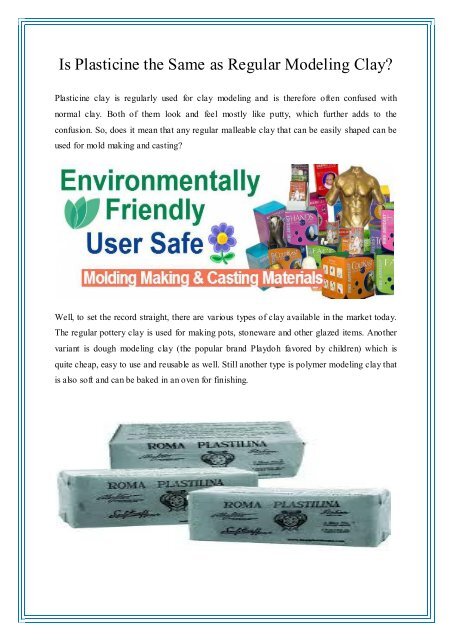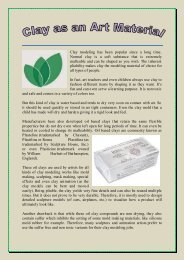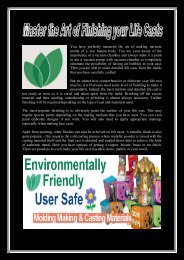Is Plasticine the Same as Regular Modeling Clay?
You also want an ePaper? Increase the reach of your titles
YUMPU automatically turns print PDFs into web optimized ePapers that Google loves.
<strong>Is</strong> <strong>Pl<strong>as</strong>ticine</strong> <strong>the</strong> <strong>Same</strong> <strong>as</strong> <strong>Regular</strong> <strong>Modeling</strong> <strong>Clay</strong>?<br />
<strong>Pl<strong>as</strong>ticine</strong> clay is regularly used for clay modeling and is <strong>the</strong>refore often confused with<br />
normal clay. Both of <strong>the</strong>m look and feel mostly like putty, which fur<strong>the</strong>r adds to <strong>the</strong><br />
confusion. So, does it mean that any regular malleable clay that can be e<strong>as</strong>ily shaped can be<br />
used for mold making and c<strong>as</strong>ting?<br />
Well, to set <strong>the</strong> record straight, <strong>the</strong>re are various types of clay available in <strong>the</strong> market today.<br />
The regular pottery clay is used for making pots, stoneware and o<strong>the</strong>r glazed items. Ano<strong>the</strong>r<br />
variant is dough modeling clay (<strong>the</strong> popular brand Playdoh favored by children) which is<br />
quite cheap, e<strong>as</strong>y to use and reusable <strong>as</strong> well. Still ano<strong>the</strong>r type is polymer modeling clay that<br />
is also soft and can be baked in an oven for finishing.
But what separates <strong>the</strong>se kinds of clay from <strong>the</strong> more advanced <strong>Pl<strong>as</strong>ticine</strong> clay versions is that<br />
<strong>the</strong> latter is an oil b<strong>as</strong>ed clay that lends itself well for mold making and c<strong>as</strong>ting works.<br />
<strong>Pl<strong>as</strong>ticine</strong> w<strong>as</strong> first invented and patented by an art teacher, William Harbutt in England in<br />
1897 and is now used <strong>as</strong> a general term. O<strong>the</strong>r clays are mostly water b<strong>as</strong>ed and tend to<br />
become quite sticky <strong>as</strong> well.<br />
Ano<strong>the</strong>r major benefit is that while most types of clay tend to harden over time (exposure to<br />
air makes <strong>the</strong> water evaporate) and can even develop cracks, <strong>the</strong> pl<strong>as</strong>ticine variants will not<br />
harden, dry or crack ever! They can always be softened by warming and <strong>the</strong>n used <strong>as</strong> desired.<br />
But you have to be careful <strong>as</strong> it can even flame at high temperatures.<br />
This is why pl<strong>as</strong>ticine is a popular mold making material in clay modeling, especially for<br />
making resin or metal c<strong>as</strong>ts. Fur<strong>the</strong>r, <strong>the</strong> non drying and flexible properties of <strong>Pl<strong>as</strong>ticine</strong> clay<br />
also make it extremely useful in m<strong>as</strong>k making, special effects and especially clay animation.<br />
The high appeal in <strong>Clay</strong>mation or stop motion animation springs from <strong>the</strong> fact that pl<strong>as</strong>ticine<br />
can be e<strong>as</strong>ily molded to create any type of character, h<strong>as</strong> <strong>the</strong> flexibility that will allow that<br />
character to be moved in many ways and also h<strong>as</strong> <strong>the</strong> required density to retain its shape even<br />
when it h<strong>as</strong> to be combined with a wire armature. Fur<strong>the</strong>rmore, it will resist melting under <strong>the</strong><br />
hot studio lights.
The inherent flexibility also makes industrial pl<strong>as</strong>ticine clay very popular for modeling<br />
works in automotive design studios. Designers use this clay for making automobile<br />
prototypes that will serve <strong>as</strong> models. Then <strong>the</strong>re is ano<strong>the</strong>r variant of ballistic pl<strong>as</strong>ticine clay<br />
that comes in useful <strong>as</strong> a backing material for testing body armor.<br />
But one drawback is that <strong>the</strong> sulfur content of pl<strong>as</strong>ticine can inhibit <strong>the</strong> setting of some<br />
silicone mold rubbers (unless you are using sulfur free pl<strong>as</strong>ticine that is also available).<br />
Therefore, while some artists may still use regular clays, <strong>Pl<strong>as</strong>ticine</strong> proves most popular and<br />
useful when it comes to clay modeling!<br />
Address: 18 Bank Street, Suite 1,<br />
Summit, NJ 07901, USA<br />
E-mail: info@artmolds.com<br />
Call: (866) 278-6653<br />
Fax: (908) 273-9256<br />
Website: www.artmolds.com







